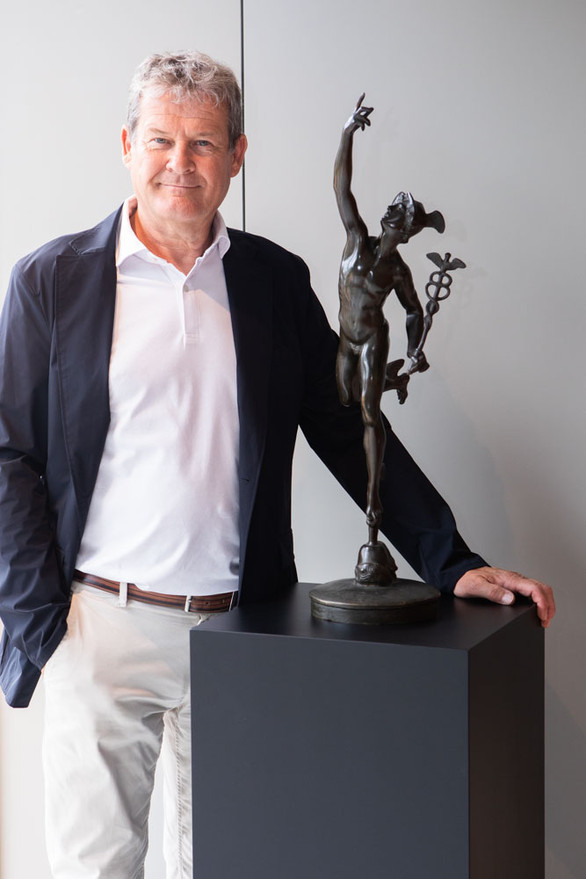Text © World of Showjumping
Luc Schelstraete – managing partner of Schelstraete Equine Lawyers, founder of European US Asian Equine Lawyers and legal counsel of the Dutch Association of Sport Horse Dealers – believes that professionals who sell horses need to unify in order to be able to have the necessary influence on the legislation that regulate the equine trade. “We are talking about a billion-Euro industry. In my opinion, there should absolutely be an international alliance representing the professional horse sellers,” Schelstraete says to World of Showjumping.
“Today, there are several individuals that are working on legal issues relevant for the international horse trade. However, beyond national level no one is unified, and in my opinion, they should be,” Schelstraete says. “There is no international union representing the professional horse sellers, so there is no strong lobby to influence the law makers – nor nationally, nor towards the EU. To have an alliance, rather than raising concerns on an individual level, would make a difference. Lifting relevant topics to a more general level would create a legal debate, rather than discussing on a case-to-case basis. We have a huge industry, but it needs to be represented correctly otherwise I believe it will suffer economically at one point.”
In his job as a lawyer, Schelstraete is fully focused on the equine business as is his legal team that works from offices in Amsterdam and ‘s-Hertongenbosch in the Netherlands. “Actually, I used to be a rider myself and fifteen years ago I had a barn full of showjumpers. Then I stopped with the jumping horses and started up with my wife Jonna, who is an international dressage rider. Today we run Schelstraete Dressage, and both our daughters compete as well. The horses are a way of living for my family and me. Hence, I have been happy that my legal practice has developed into this niche in the equine business,” Schelstraete tells.
Through his many cases at Schelstraete Equine Lawyers, as well as the international alliance European US Asian Equine Lawyers he helped to found, Schelstraete has first-hand experience with internationallegal topics he wishes more professional horse sellers would get engaged in. “Currently, there are two issues that I would like more awareness around and they are both of international importance,” Schelstraete says.
“The first is a new EU directive [2019/771] for consumer* protection in which the European Parliament and the Council have instructed the member states to implement a number of even more far-reaching mandatory consumer law provisions in their legislation than what is the case today. The implementations have to be done before 1 July 2021,” Schelstraete says. “These directives are an obligation for the member states, they can’t run away from them. This particular directive strengthens the consumers’ protection in the purchase of goods – a term which currently also includes live animals such as sport horses.”
“Under the current EU-regulations that apply today, a consumer who purchases a horse from a professional seller is protected for a period of six months should there be a defect that is deemed to have been present at the time of delivery,” Schelstraete says. “It’s up to the seller to give proof of the opposite. When you buy a bike or a dishwasher – a technical piece of equipment – this is not a big problem. However, when you buy a horse – a living animal – it is. A horse can be winning at every single show when you sell it but start stopping with the new rider – we all know that. It can be sound, but then go lame. While the seller often will blame problems like these on the buyer, there is lots of case law in which the consumer buyers’ claims – or parts of the claims – have been granted by the judge. The result is often that the purchase agreement is annulled, with the seller having to refund the money received from the buyer. Sometimes, the seller is also ordered to pay a compensation to the buyer.”
Schelstraete points out that even with an extensive pre-purchase vet-check, the seller can be deemed liable. “When the seller has to prove that a defect was not present at the point of the sale, there are indeed judges that accept the pre-purchase examination as such proof,” Schelstraete says. “However, this will depend on the defect in question. Let’s say there is a navicular-bone issue, and the horse is lame from it. During the pre-purchase vet-check, the navicular-bone has been x-rayed and concluded to be correct. If new x-rays show the defect four to five months following the date of the purchase, then it’s for me obvious that the judge should agree that the defect has not been there at the time of the sale and that the seller has given proof of that. There are many other issues though where establishing proof is difficult. One example would be tendon injuries, which often are difficult to antedate. If the seller cannot antedate the injury, the question is who should suffer from this and many judges decide in the favour of the consumer-buyer.”
“In general, we see that the pre-purchase examinations are getting more and more extensive,”Schelstraete says. “It’s no longer only clinical examinations and x-rays but also MRIs. But even with all of these pre-purchase examinations, the seller can end up losing the case if the injury cannot be antedated. In my opinion, we have to ask ourselves where we are heading with this. I think we need more international standards for the vet-checks, and not such a huge variety. It’s a risky business for the vets too and I think we see that many of them are getting careful in giving conclusions.”
“The new EU directive makes matters even worse, as the consumer protection towards the professional seller has been suggested extended from the current six months to between a min. of 12 and a max. of 24 months. The member states will decide individually on the exact length,” Schelstraeteexplains. “For the horse trade and the professional sellers, this is a development that I fear. There will be a big risk for the professional who sells to a consumer buyer.”
“Under this new directive, there is however an opportunity for the member states to make an exception for live animals,” Schelstraete continues. “I have looked into this, and as far as I can see most of the member states have so far not been opting for this possibility. To not make use of this exception for horse sales makes no sense to me. In my experience, within a few weeks or months, the new owner can have made huge damage that has nothing to do with the seller. My opinion is that there should be a strong lobby in the individual member states to defend the interests of the professional horse sellers.”
“If I was a professional seller, I would only sell to companies and not to consumer buyers. It’s simply too much risk for the seller, and this risk will increase with the new directive. For the industry, I think it’s time to encourage the individual member states to make an exception for the horse sales under this new directive. Those that are in the business should unify and be aware that they need to work actively towards the legislators to be exempted,” Schelstraete says.
“The second topic I believe is very important, and to many confusing and frustrating, is VAT on export of horses from the EU to non-European countries,” Schelstraete says. “The tax authorities in many European countries – specifically Belgium, Germany and Netherlands – have over a long period of time been very focused on equine businesses. They have established a group of tax inspectors to inspect the equine businesses’ bookkeeping to check if the VAT regulations have been applied correctly or not.”
“In my job, I see several different implementations of the VAT regulations. One of the most important aspects to know is that when your company sells a horse to a non-EU-buyer – in for example Saudi or Qatar – it’s a normal approach to invoice without VAT because the horse will leave the European Union,” Schelstraete explains. “A horse that has to leave the EU, has to leave as soon as possible. The horse will not be allowed to be consumed by the buyer in the EU. Many are not aware of this, and will sell the horse, send the invoice but perhaps keep the horse in their stable for competition and training purposes. If the seller does so, he or she has to invoice the sale with VAT.”
“So, how fast does the horse have to leave without VAT being added? There is no identical approach, which is risky business. Let’s say there is an international yard where the buyer of the horse trains with the seller – preparing for competition. In this case, the new owner/rider will be consuming and there will be a problem if the horse is sold without adding VAT. There is also another scenario. Let’s say an American buyer purchases a horse from Belgium. The horse is exported a week later, so no problem in regard to the VAT there. However, a few weeks later the horse comes back to Europe on an ATA carnet. In this particular case, the buyer/owner might receive a claim from the tax authorities. However, this is not a fraud attempt in regard to the VAT as the buyer simply brings the horse to their home country before taking it to Europe to compete due to the international nature of the sport.”
“The other problem we sometimes see, is that non-European riders come to Europe and open an entity here – a limited liability company for example. If the tax authorities have a control, they will often claim that the company is not an economic entity but an entity to avoid VAT because there is no real business,” Schelstraete explains.
“All these examples take place on a large scale; the question is how can this be solved? In my opinion, one alternative would be to lower the VAT rates – to always claim 6% rather than in certain cases claim 21-22%. Then there is no doubt, and there are no risks of making mistakes. If we don’t approach this issue at international level, it will in my opinion harm the interest of the equine business. Confusing VAT regulations is not encouraging the number of horse deals, so an agreement on international standards for export and VAT should be found,” Schelstraete closes off.
*Definition of consumer in the directive: Consumer means any natural person who, in relation to contracts covered by the directive, is acting for purposes which are outside that person's trade, business, craft or profession.
No reproduction without written permission, copyright © World of Showjumping










